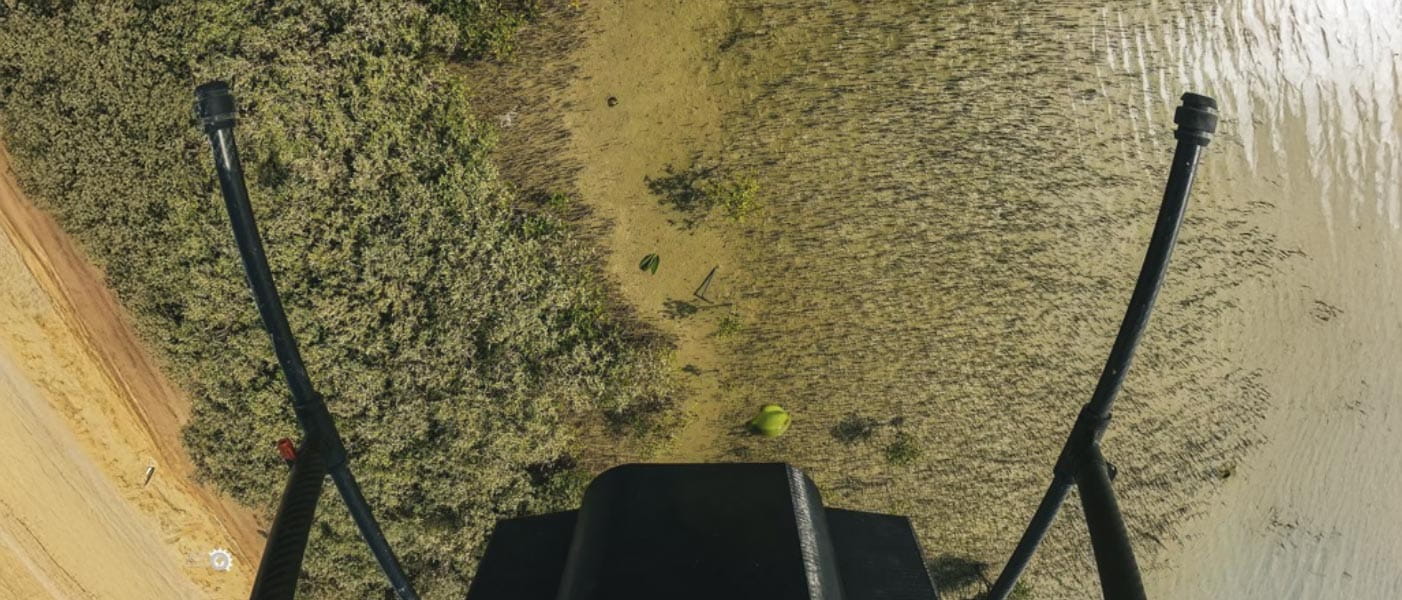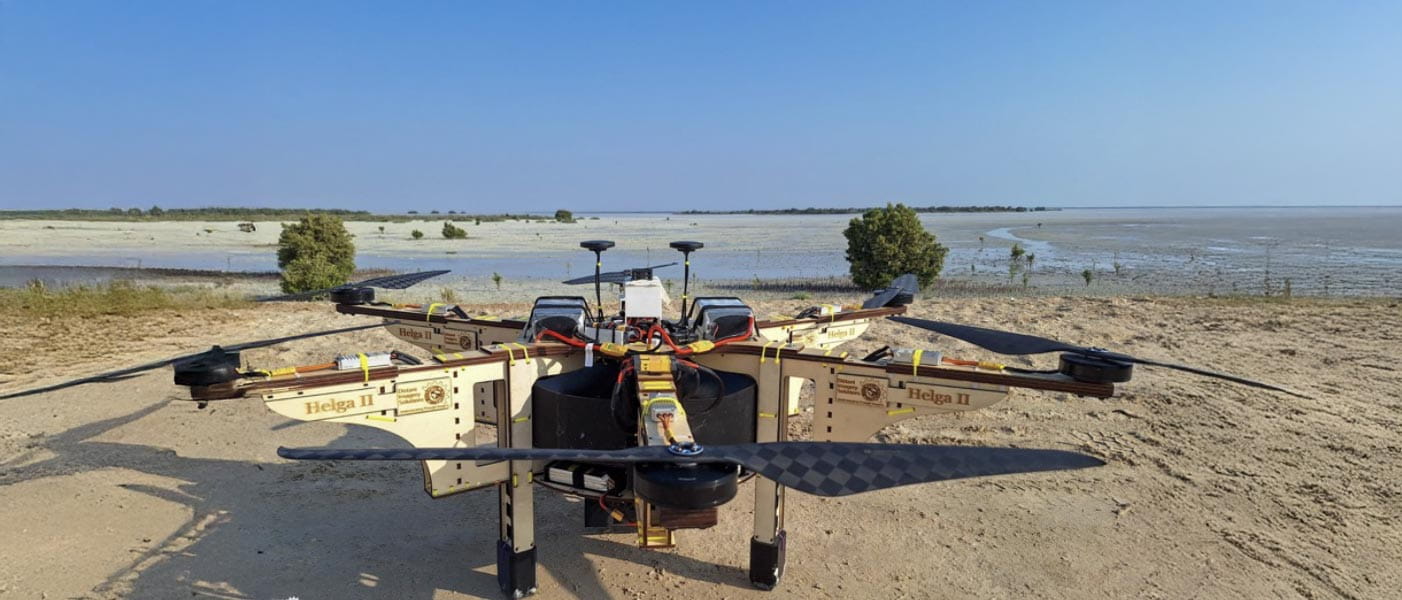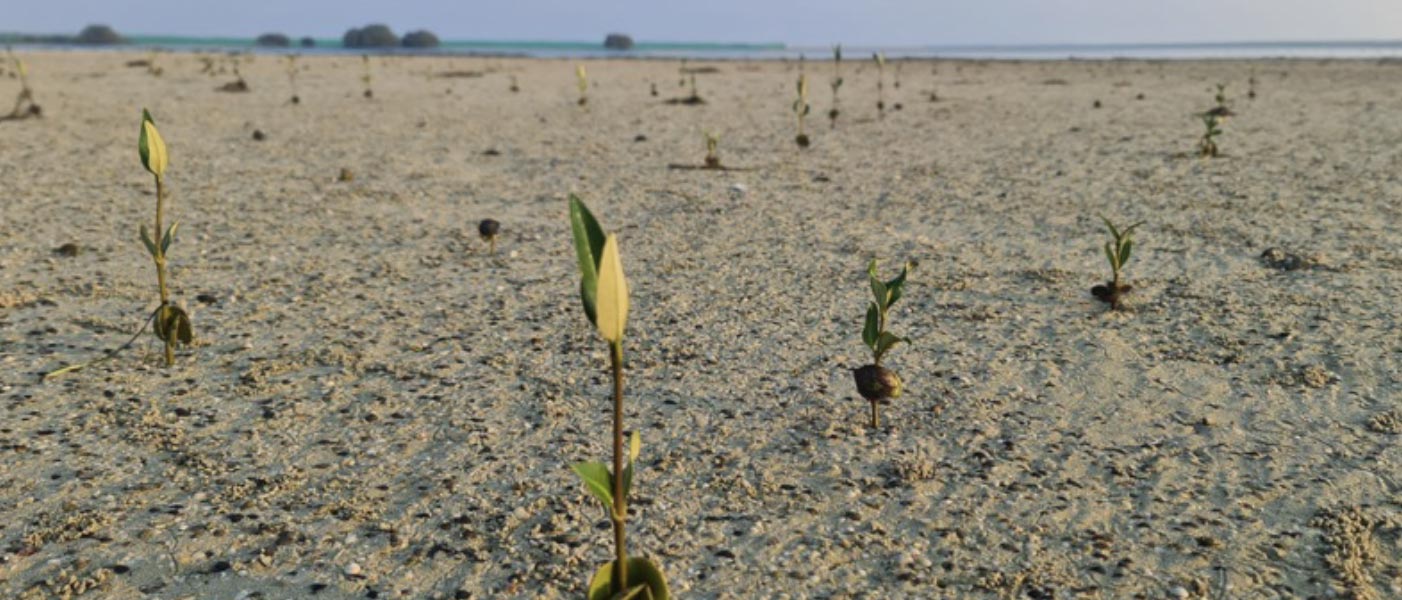Read the latest thoughts and analysis on breakthrough solutions driving impact for a sustainable future
How can technology help solve the climate crisis? By empowering vulnerable communities
16 DECEMBER 2024
6199

By Jane Glavan, Co-founder, Distant Imagery
As a climate-tech entrepreneur, I have seen first-hand the incredible power of innovation to help us tackle the climate crisis. But to drive real impact, we must design technologies that empower communities in the global south. Here’s how it can be done.
I’ve been lucky enough to see amazing work being done to harness the power of technology in the fight against climate change. But my heart sinks when I hear about climate tech being used as a kind of box-ticking exercise.
Too often, companies announce they’re launching a project to address climate change, but in reality the impact on the ground doesn’t match the hype. Because of the urgency of the problem, superficial, short-term fixes can seem very tempting. But when solutions are designed or imposed from the outside, without consulting the vulnerable communities they seek to help, they risk being ineffective and wasteful.
Thankfully, those with the power to drive climate innovation are becoming increasingly aware of the importance of community engagement and inclusivity. But unless climate tech companies adopt this mindset from the very start, these important considerations risk being reduced to afterthoughts. At worst, terms like “community engagement,” “inclusivity” and “integrity” can become mere buzzwords, emptied of any real meaning.
Why is this happening? And how can climate innovators make sure they don’t do more harm than good? I believe it all comes down to a few guiding principles.
Let nature guide the tech
Climate technology only brings value if you start with nature: What is the challenge we are trying to solve? How can we work with nature, to help facilitate, support or upscale it? As engineers or scientists, inevitably many climate tech companies approach a problem from a technical perspective. But in order to create meaningful, lasting change, it is vital to first take the time to understand the natural processes involved.

A self-engineered drone mechanical drive mechanism designed by Distant Imagery specifically for mangrove seed planting at scale in Abu Dhabi
At Distant Imagery, we work collaboratively with the communities to understand local ecosystems, and they share with us the knowledge handed down over generations. Together, we then create the climate tech – and modify devices like drones to suit the particular requirements of their local environment. That way, they can build, operate and repair the devices themselves. Crucially, in the long term, they also receive the proceeds from any nature-based projects they develop using this technology.
Keep it simple
It is important not to create technology just because you can, or because it ticks a satisfying box for someone in a distant corner office. I have seen initiatives that offer a community a piece of impressive – and expensive! – new technology, and perhaps minimal training, but don’t share the knowledge of how to repair or upgrade it. What use is a piece of tech if it takes eight months to order a new part when it goes wrong? These kinds of short-sighted innovations can make it harder for those who want to do it right.

A low-tech drone designed and built by Distant Imagery
By working more directly with vulnerable communities and without preconceived ideas, scientists can create tools that are fit for purpose and cost-effective. A small island community probably doesn’t need an over-engineered $100,000 drone! Quite often the answer lies in stripping things down. By listening and understanding the real-world needs of the local community, we can pare back the solution, so it is focused just on what is needed. That might be a drone made from wood using six screws, or a kite you can sew together.
The aim should be to create simple, efficient, accessible devices that can be used over the long term, by as many people as possible and can be adapted for a range of different ecological settings. The most resilient, adaptable solutions should aim to use locally available materials and be led by those who will use them into the future.
Innovate to empower
Low-income communities all over the world are feeling the impacts of climate change most acutely, and climate tech can empower communities in the global south to become more resilient. I firmly believe that by democratizing tech solutions, we can address climate change mitigation and adaptation goals at scale and create more resilient societies and ecosystems in the process. Unlike traditional approaches, the communities we work with are not just beneficiaries – they are partners in every sense of the word.

Community members prepping seeds to be dispersed by a Distant Imagery drone
In Kenya, we are working with Mikoko Pamoja, the world’s first community-led blue-carbon mangrove conservation project. With them, we are designing small, nimble drones that will help with monitoring, verification and reporting (MRV) on the health of the mangroves. This means they can lower the cost of MRV and channel more of the revenue from the carbon credits they sell.
We’re also working with the Kingdom of Tonga on restoring their mangroves for better coastal protection and ecosystem health. Communities there have complete control over the restoration process and ownership of the technology, building, modifying and operating the drones and aerial tools we designed for them. And we’re working with the Indonesia Climate Change Trust Fund to restore 600,000 hectares of mangroves, enhancing biodiversity and carbon sequestration and protecting key areas of Indonesia from further coastal erosion.
In our partnership with the Borari tribe in the Brazilian Amazon, we’re providing innovative solutions to protect their ancestral lands and preserve their natural heritage. By designing cost-effective solutions including drones, we can empower them to gather data that allows them to both address forest threats and explore revenue options such as bee farming and medicinal plant cultivation.
By equipping communities with the tools, knowledge and skills they need to build, operate, and adapt technology for various conservation and monitoring efforts, we can enable sustainable, large-scale environmental impact at a fraction of traditional costs. This model also ensures that local communities retain ownership and control over their restoration and monitoring projects.
Advocate for patient finance
Climate tech companies have another opportunity to challenge the status quo: by helping to drive change in the way climate projects are funded. Our global financial system is geared to seek out the highest return on investment, shying away from perceived risk and protecting business interests.
But building long-term, sustainable and equitable solutions to climate change takes time. It requires patience to understand local ecosystems – their threats, their benefits, their potential – and to listen and learn from the communities that have stewarded them for generations.

Coastal mangrove seedlings in Abu Dhabie five months after planting by a drone
We need to create a financial environment and regulatory frameworks that allow for this collaboration, because ultimately those are the projects that will be both profitable and sustainable.
We do this by providing communities with tools to protect and restore their ecosystems without needing western partners or external funding in the long term. By combining indigenous knowledge and cutting-edge technology, they can identify and seize opportunities to build resilience – such as ecosystem restoration, scaled-up production or enhanced revenue streams.
Radical collaboration
By learning from indigenous knowledge, working with nature and democratizing access to tech and funding, climate innovators have an extraordinary opportunity: to focus on solutions that are practical, cost-effective and reach as many people as possible. Technology is just a tool – its real value is in empowering those on the frontlines of climate change to design their own resilient future in our changing world.
As a climate-tech entrepreneur, I have seen first-hand the incredible power of innovation to help us tackle the climate crisis. But to drive real impact, we must design technologies that empower communities in the global south. Here’s how it can be done.
I’ve been lucky enough to see amazing work being done to harness the power of technology in the fight against climate change. But my heart sinks when I hear about climate tech being used as a kind of box-ticking exercise.
Too often, companies announce they’re launching a project to address climate change, but in reality the impact on the ground doesn’t match the hype. Because of the urgency of the problem, superficial, short-term fixes can seem very tempting. But when solutions are designed or imposed from the outside, without consulting the vulnerable communities they seek to help, they risk being ineffective and wasteful.
Thankfully, those with the power to drive climate innovation are becoming increasingly aware of the importance of community engagement and inclusivity. But unless climate tech companies adopt this mindset from the very start, these important considerations risk being reduced to afterthoughts. At worst, terms like “community engagement,” “inclusivity” and “integrity” can become mere buzzwords, emptied of any real meaning.
Why is this happening? And how can climate innovators make sure they don’t do more harm than good? I believe it all comes down to a few guiding principles.
Let nature guide the tech
Climate technology only brings value if you start with nature: What is the challenge we are trying to solve? How can we work with nature, to help facilitate, support or upscale it? As engineers or scientists, inevitably many climate tech companies approach a problem from a technical perspective. But in order to create meaningful, lasting change, it is vital to first take the time to understand the natural processes involved.

A self-engineered drone mechanical drive mechanism designed by Distant Imagery specifically for mangrove seed planting at scale in Abu Dhabi
At Distant Imagery, we work collaboratively with the communities to understand local ecosystems, and they share with us the knowledge handed down over generations. Together, we then create the climate tech – and modify devices like drones to suit the particular requirements of their local environment. That way, they can build, operate and repair the devices themselves. Crucially, in the long term, they also receive the proceeds from any nature-based projects they develop using this technology.
Keep it simple
It is important not to create technology just because you can, or because it ticks a satisfying box for someone in a distant corner office. I have seen initiatives that offer a community a piece of impressive – and expensive! – new technology, and perhaps minimal training, but don’t share the knowledge of how to repair or upgrade it. What use is a piece of tech if it takes eight months to order a new part when it goes wrong? These kinds of short-sighted innovations can make it harder for those who want to do it right.

A low-tech drone designed and built by Distant Imagery
By working more directly with vulnerable communities and without preconceived ideas, scientists can create tools that are fit for purpose and cost-effective. A small island community probably doesn’t need an over-engineered $100,000 drone! Quite often the answer lies in stripping things down. By listening and understanding the real-world needs of the local community, we can pare back the solution, so it is focused just on what is needed. That might be a drone made from wood using six screws, or a kite you can sew together.
The aim should be to create simple, efficient, accessible devices that can be used over the long term, by as many people as possible and can be adapted for a range of different ecological settings. The most resilient, adaptable solutions should aim to use locally available materials and be led by those who will use them into the future.
Innovate to empower
Low-income communities all over the world are feeling the impacts of climate change most acutely, and climate tech can empower communities in the global south to become more resilient. I firmly believe that by democratizing tech solutions, we can address climate change mitigation and adaptation goals at scale and create more resilient societies and ecosystems in the process. Unlike traditional approaches, the communities we work with are not just beneficiaries – they are partners in every sense of the word.

Community members prepping seeds to be dispersed by a Distant Imagery drone
In Kenya, we are working with Mikoko Pamoja, the world’s first community-led blue-carbon mangrove conservation project. With them, we are designing small, nimble drones that will help with monitoring, verification and reporting (MRV) on the health of the mangroves. This means they can lower the cost of MRV and channel more of the revenue from the carbon credits they sell.
We’re also working with the Kingdom of Tonga on restoring their mangroves for better coastal protection and ecosystem health. Communities there have complete control over the restoration process and ownership of the technology, building, modifying and operating the drones and aerial tools we designed for them. And we’re working with the Indonesia Climate Change Trust Fund to restore 600,000 hectares of mangroves, enhancing biodiversity and carbon sequestration and protecting key areas of Indonesia from further coastal erosion.
In our partnership with the Borari tribe in the Brazilian Amazon, we’re providing innovative solutions to protect their ancestral lands and preserve their natural heritage. By designing cost-effective solutions including drones, we can empower them to gather data that allows them to both address forest threats and explore revenue options such as bee farming and medicinal plant cultivation.
By equipping communities with the tools, knowledge and skills they need to build, operate, and adapt technology for various conservation and monitoring efforts, we can enable sustainable, large-scale environmental impact at a fraction of traditional costs. This model also ensures that local communities retain ownership and control over their restoration and monitoring projects.
Advocate for patient finance
Climate tech companies have another opportunity to challenge the status quo: by helping to drive change in the way climate projects are funded. Our global financial system is geared to seek out the highest return on investment, shying away from perceived risk and protecting business interests.
But building long-term, sustainable and equitable solutions to climate change takes time. It requires patience to understand local ecosystems – their threats, their benefits, their potential – and to listen and learn from the communities that have stewarded them for generations.

Coastal mangrove seedlings in Abu Dhabie five months after planting by a drone
We need to create a financial environment and regulatory frameworks that allow for this collaboration, because ultimately those are the projects that will be both profitable and sustainable.
We do this by providing communities with tools to protect and restore their ecosystems without needing western partners or external funding in the long term. By combining indigenous knowledge and cutting-edge technology, they can identify and seize opportunities to build resilience – such as ecosystem restoration, scaled-up production or enhanced revenue streams.
Radical collaboration
By learning from indigenous knowledge, working with nature and democratizing access to tech and funding, climate innovators have an extraordinary opportunity: to focus on solutions that are practical, cost-effective and reach as many people as possible. Technology is just a tool – its real value is in empowering those on the frontlines of climate change to design their own resilient future in our changing world.


